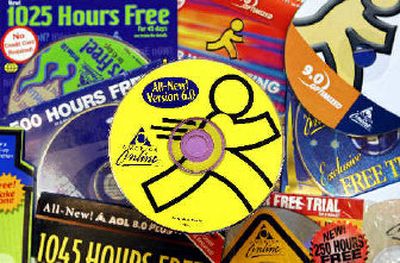AOL opens the wall

NEW YORK — The company responsible for introducing millions of people to the Internet is poised to undergo a transformation that would likely accelerate its decline as a gatekeeper of access to the information superhighway.
Time Warner Inc.’s board is expected to review on Thursday a proposal for its AOL LLC online unit to make even more services free, likely including the vaunted AOL.com e-mail accounts, in hopes of boosting advertising.
The strategy is risky: Millions of customers would likely drop their paid subscriptions, and AOL would lose hundreds of millions of dollars a year, perhaps even a billion or more, for the promise of an advertising payoff some time in the future.
But AOL has little choice. Its subscription business will keep eroding regardless. Internet advertising, meanwhile, is booming industrywide, and opportunities abound with ad-supported online video, a strong point for AOL.
“It’s a risky game they’re playing, but it would be riskier not to play,” said David Hallerman, a senior analyst with research company eMarketer Inc.
AOL got its start in 1985 as a provider of a proprietary online service, then known as Q-Link. Though it gradually allowed users to venture off to the public Internet, AOL tried its best to keep users within its walled gardens filled with exclusive articles, chat rooms and other features.
Millions of Americans got their first taste of e-mail, the Web and instant messaging through discs that continually arrived in mailboxes unsolicited.
To many users, AOL was the Internet.
But most people connected then via dial-up modems.
As Americans turned to cable and phone companies for high-speed service, they saw less need to pay AOL simply for the exclusive content, even as the company offered discounts for those who didn’t need unlimited dial-up access — currently $11 off the $26 monthly fee.
After peaking in September 2002 with 26.7 million U.S. customers, AOL’s subscription base plummeted 30 percent, to 18.6 million in March.
It’s still the largest Internet service provider, but AOL faces the reality that fewer and fewer Americans want dial-up. Roughly two-thirds of AOL’s subscribers are on dial-up plans, while nearly two-thirds of U.S. Internet users have broadband at home.
Over the past year and a half, AOL has aggressively moved most of its content — news, music videos, chat rooms — to free, ad-supported Web sites. Last year, ad revenues grew 33 percent, even as subscription revenues declined by 10 percent.
However, the company kept AOL.com e-mail a premium offering, giving free accounts only with less-desirable AIM.com addresses. Many subscribers hung on, but over time found the free offerings from Yahoo Inc., Microsoft Corp. and Google Inc. too sweet to resist.
AOL’s proprietary software for checking e-mail, among other things, became even less of a draw as its rivals made their Web-based tools richer and easier to use.
“Just about everything AOL offers, you can get free from Google, Microsoft or somewhere else,” said Dave Burstein, editor of the industry newsletter DSL Prime. “How long are people going to pay for that?”
Free e-mail is particularly important because the service is used often. As users check e-mail on an ad-supported Web page, Hallerman said, they may stumble upon a video or other content, boosting AOL’s ad opportunities.
Keeping users on the paid service merely risks sacrificing those opportunities forever, said Jeff Lanctot, general manager of aQuantive Inc.’s Avenue A/Razorfish, an online advertising agency that places ads on AOL sites.